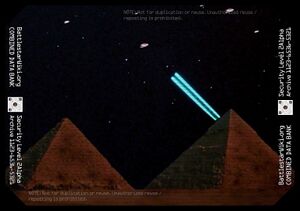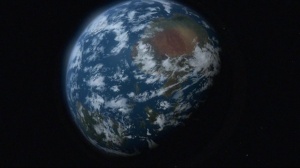Kobol
More actions
Kobol is the ancestral homeworld for humanity in both Battlestar Galactica sagas. In both series, an unexplained event or environmental catastrophe causes humanity to leave Kobol and settle on the planets that form their new homeworlds known as the Twelve Colonies.
Kobol in the Original Series

In the Original Series, Kobol was the mother world where mankind originated. An ecological / environmental disaster led to humanity's migration. During the migration, 12 tribes set out for the stars, but became lost in a starless void before stumbling into the worlds that would become the new Twelve Colonies of Man, while the 13th again headed for a world called "Earth."
Kobol is rediscovered in the two-part episode, "Lost Planet of the Gods." A team from Galactica arrives among the ruins of Eden, the planet's largest city, seeking to enter the tomb of the Ninth Lord of Kobol in order to find clues as to the route taken by the Thirteeth Tribe. A Cylon attack ultimately prevents them from doing so.
Kobol in the Re-imagined Series

Kobol is a planet said to be the home of the original thirteen tribes of mankind, once shared in harmony with the Lords of Kobol.
Kobol is a verdant world of seas and continents, the latter having large areas of woodland, grassland and forests. It was located in Sector 218 of the galaxy (Kobol's Last Gleaming, Part I).
The seat of power of Kobol resided in the City of the Gods in the northern hemisphere, itself dominated by the Forum, Temple and Opera House (Kobol's Last Gleaming, Part I), structures which were duplicated on Caprica in the city of Delphi.
Great Exodus
The Great Exodus from Kobol took place some 2,000 years prior to the events of the Miniseries. At that time, the remaining Twelve Tribes departed Kobol for another star system.
It is unclear whether all the gods themselves departed Kobol at this time, although the Sacred Scrolls indicate that Athena commits suicide in sorrow at the human exodus, suggesting that one or more gods or humans remained to record the death before entombing Athena and leaving themselves.
It is known that the Thirteenth Tribe departed Kobol some time before the main exodus (Miniseries), to seek a planet known as "Earth." The gods appear to have abandoned Kobol as well, but aired information does not establish a time of departure.
Religious Texts
During the time humans lived on Kobol, many texts were written, some of which have survived through time, and are regarded by some as religious artifacts, and by others the documenting of myths and legends. These texts have apparently been collected into a tome known as the Sacred Scrolls.
Chief among these writings include the Book of Pythia who, some 1,600 years prior to the Great Exodus, fortold another exodus featuring a "caravan of the heavens" lead by someone dying of a "wasting disease" (The Hand of God). This exodus would lead humanity to a new home, although the leader would die before he/she could enter the new home.
Some of the writings of Pythia have apparently come true: President Laura Roslin, the civil leader of the Colonial fleet is dying of cancer at the presumed fulfillment of the prophecy (Home, Part II). Further, Roslin has several visions, including one of 12 snakes (The Hand of God), a vision specifically foretold by Pythia.
According to an virtual image of Number Six that appears to Gaius Baltar, the Cylons have very different beliefs about Kobol, including that human sacrifice was practiced there, and that the souls of all who die on Kobol are forever lost ("Valley of Darkness," "Fragged"). Since this "virtual Six" appears to be some sort of hallucination, this belief may be a falsehood.
Rediscovering Kobol
Kobol is re-discovered by chance when battlestar Galactica dispatches her Raptors to locate planets which may provide materials needed to re-supply the Fleet (Kobol's Last Gleaming, Part I).
Following the discovery (as predicted by the Cylon agent Leoben Conoy), Roslin becomes convinced that Kobol will lead the fleet to Earth, providing the Tomb of Athena can be accessed. To do this, the Arrow of Apollo must be retrieved from the Delphi Museum of the Colonies on Caprica.
However, before the surface of Kobol can be reached safely (and the crew of a crashed Raptor rescued), a Cylon force lead by a basestar must be eliminated. Commander Adama plans to use the captured Cylon Raider to help with this, but before any plan can be put into action, Lt. Kara "Starbuck" Thrace uses the Raider to go to Caprica in an attempt to recover the Arrow (Kobol's Last Gleaming, Part I). Commander Adama eventually uses a Raptor armed with a nuclear warhead to destroy the orbiting basestar.
President Roslin plays her role as "the Leader" sent by the Gods, and convinces a third of the Fleet to return to Kobol with her (The Farm). With the Arrow of Apollo retrieved, Roslin descends to the surface with a small team, including Lee "Apollo" Adama, Starbuck, Helo, and Tom Zarek. The copy of Sharon Valerii, who accompanied Helo on Caprica, claims to know how to help Roslin reach the Tomb of Athena, and is brought along as guide. Along the way on the surface, Roslin's team fights with additional Centurions, resulting in the death of priestess Elosha, Roslin's personal religious advisor (Home, Part I).
Commander Adama (who locates Roslin's group on the surface) joins her and the rest of the team shortly after Elosha's death. The team soon finds the Tomb of Athena. They are the first people to see the inside of the Tomb in centuries, and use the Arrow to activate a holographic map display which indicated the general direction of Earth (Home, Part II).
Similarities of Kobol between Original and Re-imagined Series
- It is the original home of humanity
- It is found by chance by both Fleets
- A world catastrophe or internal strife forces humanity to leave the planet
- A tomb holds the key to the location of Earth
- Special keys are needed to open or access the secrets of the tomb
- The Colonials encounter Cylons on and around the planet during their quests
Etymology of "Kobol"
"Kobol" originally appears to have derived from "Kolob" which, according to the Mormon Book of Abraham is the "star nearest unto God". Glen A. Larson, creator of the Original Series, is a member of the of the Church of Jesus Christ of Latter-day Saints. As such, he used Mormon imagery within the show, together with elements of Egyptian imagery that tend to reflect the time of Abraham and the Israelites. The Book of Abraham also claims that Abraham taught the Egyptians astronomy and that Kolob is the central star of the universe and thus controls the revolutions of all other stars and planets. The connection seems to come from Kolob/Kobol as the (so to speak) "original starting point".
Kobol could also have been derived from the Greek word Kobalos, meaning "mine or source." The name may suggest that Kobol was originally a planet with a wealth of natural resources (or, in the case of the Tomb of Athena, information).
Cinematic Note
In the Re-imagined Series, much of the scenic, expansive landscapes of Kobol were filmed at Widgeon Slough, the largest freshwater marsh in the the Pinecone Burke Provincial Park, Britsh Columbia, Port Coquitlam (Source in part: The Official Companion).
In the original Miniseries script of the Re-imagined Series, the Twelve Colonies actually resided on Kobol. The final script returned Kobol to its status as birthplace of man, with humanity having left to other habitable worlds to match the premise of the Original Series.
